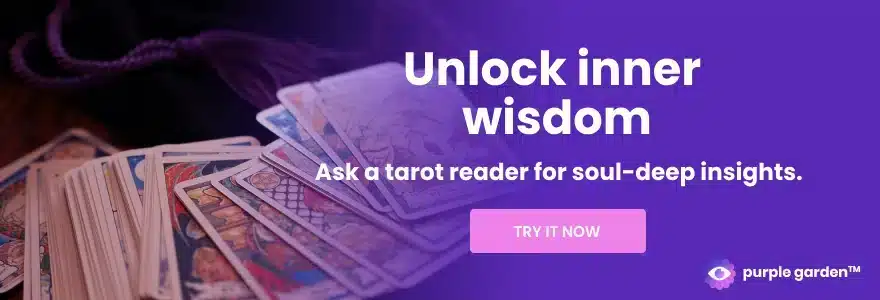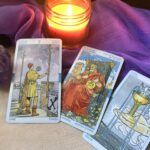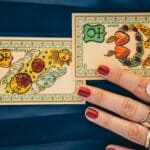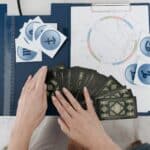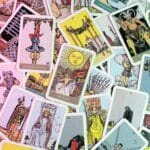Ever wonder what a tarot reading is all about? Can a tarot spread show you what lies ahead? Or do the cards only reflect what your subconscious already knows? Will the tarot cards reveal the next chapter in your life story or give you the tools to write it yourself? Discover these answers and more with Purple Garden’s tarot hub.
Welcome to your online destination for everything tarot. Get ready to dive in and explore your desires, curiosities, and uncertainties. Every card is a step closer to clarity and understanding. Tarot can be a love expert, career counselor, or life coach in the right hands. Let’s find out what it can do for you!
Table of Contents
- Navigating the Realm of Intuition: How Do Tarot Readings Work?
- Tarot Cards Unveiled: Symbols and Meanings Explored
- Journey of Discovery: Exploring Tarot Spread Variations
- Choosing Your Intuitive Companion: A Guide to Selecting Tarot Decks
- Integrating Tarot Insights into Everyday Life
- Tarot Guidance: Connecting with Experienced Advisors
- FAQs
When you delve into the world of tarot, you unlock a wealth of ancient wisdom. It’s like learning a secret language of symbols that combine to tell insightful stories.
Using cards as a tool to tap into the human psyche is a practice that spans centuries and cultures. We can look deeper inside and even beyond with something as simple as images on little pieces of paper. Your past life, the present, your future–the tarot can be both a mirror and a window to it all.
Traditional tarot isn’t the only style of cards people turn to for answers, but it’s the most popular and well-known. The typical tarot deck is 78 cards. Each one has its own special significance and profound meaning. Every card is a powerful tool that can help you understand yourself and the world around you. It all depends on you and your reader.
A tarot reading is more than shuffling and drawing cards. It’s a connection. It’s the meeting of energies between the reader’s intuition and the querent’s desires. It requires both of you to keep an open heart and an open mind.
The Ancient Origins of Tarot
Ever wondered where Tarot cards came from? The earliest recorded use is in 15th-century Europe. Some believe it’s even older. There’s a theory tarot dates back to ancient Egypt and the pages of the Book of Thoth, a revered repository of wisdom. Others believe tarot has ties to spiritual practices from ancient China or India. Whatever their origins may be, we know tarot has stood the test of time.
Who is Suitable for Tarot Reading?
If you’ve got an open mind, a desire for self-discovery, or a need for guidance, tarot is for you. Seeking clarity about a particular situation? Want to confirm your suspicions? Curious about the future? Ask the tarot. It never judges or discriminates. It’s a channel to view the patterns, possibilities, and pathways that make up your life’s journey.
Preparing for a Tarot Reading
A clear reading starts with a clear mind. Let go of any judgments or assumptions in your mind related to your question. Find a calm, quiet environment. Set up some soothing vibes with things like candles, incense, and soft music. Get comfortable, breathe, and center your mind. Then, focus on your intention or question. Tune into your inner self so you can receive and reflect on the message the cards reveal.
Questions That Can Be Asked During a Tarot Reading
If you talk to an expert tarot reader, they’ll tell you it’s better to ask open-ended questions than “ yes or no”. Are you getting a love tarot reading? Instead of asking, “When will we get married?” ask, “How do I strengthen our relationship?” or, “Where is our relationship heading?”.
The tarot deck is about interpretation, not factual details. It’s a tool to reflect and guide you. It helps you explore different possibilities and new perspectives. Don’t expect it to predict your future with certainty. Next time you get a tarot reading, ask for a beginning of the month tarot spread. Let tarot shine a light on where your path may lead in the coming weeks.
Tarot Cards Unveiled: Symbols and Meanings Explored
You know what it takes to start your tarot adventure. Now, you need the knowledge to back it up. No one becomes a tarot expert overnight. It’s the kind of tool you never really stop learning. Every card has its secrets, and every spread is open to interpretation. Plus, the energy of those involved constantly changes.
With a few fundamentals, you’ll be better prepared to navigate the tarot’s maze of meanings. A little understanding goes a long way.
The Origin and History of Tarot Cards
Take a time machine back to 15th-century Italy. When you get there, you may be among the first ever to use a deck of playing cards. Once playing cards became popular, fortune tellers started practicing cartomancy, or card reading. They divined answers from everyday playing cards by assigning a meaning to each one.
Tarot began as a way to make regular cards something special. Each tarot card was a beautiful work of art. Each featured symbols from mythology, astrology, numerology, and ancient spiritual teachings. It’s no wonder tarot became a favorite among card readers and remains so to this day.
Types of Tarot Cards
Tarot may be the most popular card for divination, but it’s not the only one. Most card readers have an oracle deck in their collection. What’s the difference between oracle cards and tarot cards? Oracle cards are like tarot’s freestyle cousin. Structure, symbolism, and meaning are all left up to the creator of the cards. Each deck is unique, with its own art and interpretation.
Tarot, on the other hand, is traditional. There are 78 cards divided into 22 Major Arcana cards and 56 Minor Arcana cards. There’s a lot left open to interpretation, but the cards have the same meaning from deck to deck.
The Major Arcana traces the cycle of life. The cards represent significant events, spiritual lessons, or archetypal themes. We all start our journey with the innocence of the Fool. We’ve all got inner power to claim like the Magician. We have to make hard decisions likethe Hanged Man. Every card relates to a major part of our human existence.
The Minor Arcana encompasses every life and different aspects of human experience. Like regular playing cards, there are four suits. Instead of hearts, diamonds, clubs, and spades, we’ve got cups, pentacles, wands, and swords in a tarot reading. Again, like playing cards, there are 10 numbered cards and four court cards–King, Queen, Knight and Page.
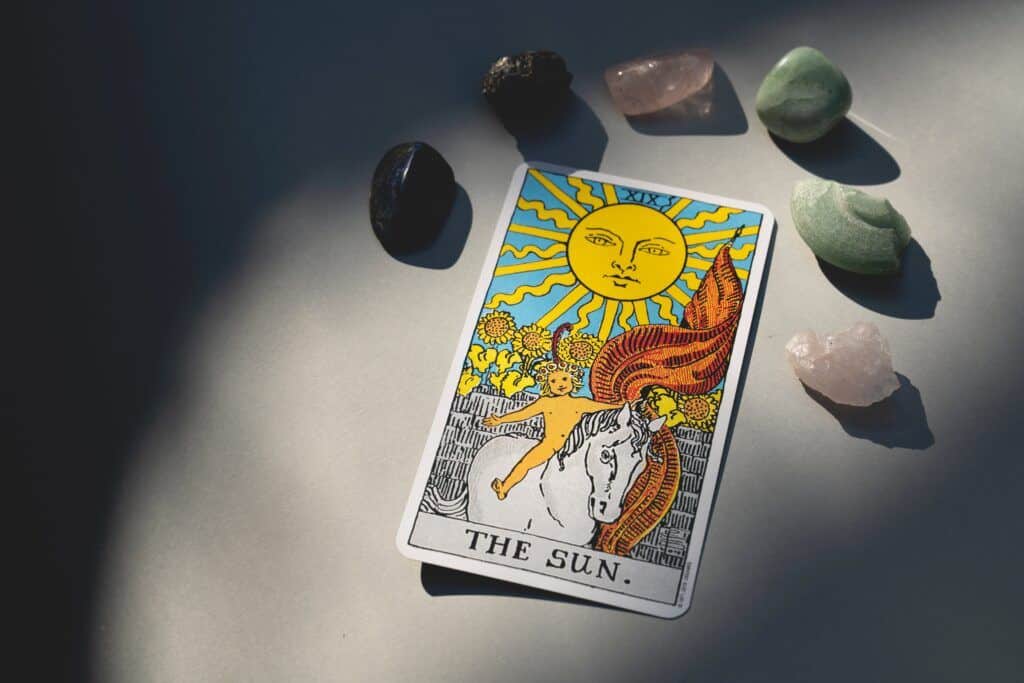
Interpreting Tarot Cards
Being a tarot reader is like being a painter. It’s important to know the basics, but the real magic lies in their own interpretation of what they learned. The painter needs their brush, paints, and imagination. The tarot reader needs their deck, a question, and intuition.
Yet, tarot isn’t art on a wall for decoration or contemplation. Tarot cards are messages directed at someone specific. Their meaning can change depending on your situation. Like the artist needs their canvas, the tarot reader needs context.
Let’s consider the Death tarot card in a love reading, for example. Don’t take this misunderstood card literally. It doesn’t foretell the end of anyone’s life but rather a transition or conclusion. In a happy relationship, the Death card can symbolize moving forward together. If you’ve been considering ending the relationship, Death might be a sign to move forward apart.
You can learn your deck by studying a tarot cards meaning list with pictures. Don’t focus on memorization. Focus on the card and the imagery, which usually hints at its meaning:
- TheEmperor card features a crowned man on a throne and represents power and authority.
- The Chariot tarot card shows a man driving a chariot, expressing forward motion and direction.
- The Hermit tarot card is an old man in a hooded robe, implying solitude and wisdom.
- The Wheel of Fortune is full of mysterious symbols, but the meaning is in the title–good luck and change.
- The 6 of Pentacles features a merchant with scales to symbolize wealth and balance
- The Knight of Cups shows a man calmly riding a white horse, representing charm and diplomacy.
Journey of Discovery: Exploring Tarot Spread Variations
So, you’re ready to shuffle the tarot deck but not sure what comes next? Let’s get to know some tarot spreads. If the context is the canvas and the cards are paints, think of a tarot spread like an outline. The artist sketches lines and shapes to connect the elements of their image.
The artist may color outside the lines, but the outline acts as a guide. Likewise, a tarot spread is a framework, a way to navigate the possibilities. The tarot reader may feel drawn in another direction, but the spread helps return their focus.
Understanding the Importance of Tarot Spreads
The individual meaning of every card isn’t the only aspect of understanding tarot. You also need to consider their relation to each other. A one-card tarot reading is great when you need a quick answer. For deeper insights, look to a 5-card tarot spread.
Tarot spreads add nuance to every interpretation and offer guidance to explore specific themes. There are tarot spreads for breakups, finding your soulmate, contacting your guardian angel, and anything else you need.
Choosing the right spread unlocks the door to new insights and tailored solutions. Understanding tarot spreads is the key to divine clarity and self-discovery.
Popular Tarot Spreads
Like we said, there’s a tarot spread for everything. Two of the most popular ones include the simple Three-Card Spread and the intricate Celtic Cross. Three-Card Spread is a favorite because there’s a card to present your past, present, and future. The 11-card Celtic Cross spread gives a broader perspective on your life. The cards explore the underlying themes and prospective outcomes.
There are more popular spreads to explore, depending on your question. If you’re crushing on someone, try a Does he like me tarot spread. Missing your ex? Check out an Is he coming back tarot spread. Curious about work? Discover the best tarot spread for careers.
How Do Tarot Spreads Function?
With a tarot spread as your outline, you can create a detailed landscape in response to any question. Each position in the spread has its unique energy, shedding light on various facets of your life. When you lay down the cards, the spread is the framework that shapes your bigger picture.
There’s a dynamic between the cards, which highlights obstacles and opportunities. With a tarot spread, 78 cards turn into endless possibilities.
Choosing Your Intuitive Companion: A Guide to Selecting Tarot Decks
Are you ready to buy your first tarot deck? Listen to your intuition and choose cards that resonate with you. If you’re a beginner or a traditionalist, you might opt for the Rider-Waite deck, and it’s art nouveau style. Or maybe you want a different design for your deck, like cute and whimsical or dark and gothic. Maybe you want a deck based on your favorite movie or TV show.
Whatever your tastes, the right deck can transform your tarot experience. A deck you connect with strengthens intuition, whether you’re a newbie or an expert.
Tarot Decks Through History
As we mentioned, tarot took off following the popularity of playing cards in the 15th century. Early decks like the Visconti-Sforza and Marseilles are the pillars of modern tarot.
Italian nobles were the first to commission tarot decks in the 1400s. It was only something the elite could do at the time, as an artist would paint each one by hand. Still, these cards look a lot like the tarot decks we use today with images like Death, the Fool, and the Empress.
After the invention of the printing press, tarot cards started to circulate more and more. Italian tarot made its way into France with the Tarot of Marseille. This simple playing card-styled version is still popular today.
The Most Famous Tarot Decks
In modern times, the most popular deck is referred to as the Rider-Waite tarot. It’s also, more appropriately, known as the Smith-Waite tarot. This name change honors the artist behind the cards we know and love, Pamela Colman Smith.
Smith illustrated the deck at the direction of mystic A.E. White. They were both members of the Hermetic Order of the Golden Dawn, which inspired their work. The deck was published in 1909 and remains a fundamental element of tarot reading.
Another popular modern tarot deck is the Thoth Tarot. This was the design of another Golden Dawn member, mysterious occultist Aleister Crowley. The deck, illustrated by Lady Frieda Harris, is a unique reflection of Crowley’s spiritual, scientific, and magical views. Like Crowley himself, the Thoth Tarot is mystical and complex.

Tarot Decks Basics
Let’s recap what makes a deck of cards earn the tarot title in a traditional sense:
- 78 cards divided into 22 Major Arcana cards and 56 Minor Arcana cards.
- The Major Arcana comprises 22 cards representing life’s bigger themes and spiritual lessons.
- The Minor Arcana consists of 56 cards depicting everyday situations and challenges.
You might find yourself drawn to a deck that deviates from these norms, and that’s okay. Tarot is a deeply personal practice. It’s not about the deck you use but how you interpret the cards. Traditional or modern, it’s more about finding a deck you love. It should feel like an extension of yourself, one that broadens your mind.
Integrating Tarot Insights into Everyday Life
Let’s take tarot cards off the pedestal. They’re not inherently magical, they won’t make you a fortune teller, and they’re certainly not dangerous. Tarot is a tool. Anyone can use it and enjoy it. Some will become experts in it. Some will turn to it as a spiritual practice. Others will consider it a hobby.
Whatever tarot is to you, it has the potential to fill your world full of insights. You’ll learn more about yourself, how you relate to those around you, and whatyour life purpose could be. Tarot is like having a personal guide in your pocket that helps you make sense of the world.
Uniting Past, Present, and Future with Tarot
Remember why a three-card reading is so popular? We all have questions about the past, present, and future. What lessons can we learn from our history? What messages do we need to hear right now? Are we on our ideal path?
Spend some time focusing on your questions, then draw your cards and reflect on the imagery. Can you get a sense of recurring themes? Are there patterns in every phase of your life? Recognize what repeats and how you can adapt so your habits align with your goals.
Using Tarot for Informed Decision-Making
When you’re at a crossroads, tarot cards can point you in the right direction. Can tarot cards be used for marriage predictions? Can they tell you which job to take or who to date? Sure, but look beyond your initial impressions.
Tarot doesn’t give a straightforward answer. It gives you options. It lets you look through a new and different lens. Tarot clarity can empower you to make confident decisions that align with your goals.
Infusing Daily Practices with Tarot Insights
If you use tarot cards every day, you can improve your connection to your intuition. They can help you access your innermost thoughts more easily. Each card can teach you about yourself, your desires, and your fears.
Every morning, draw a card and reflect on its meaning. Throughout the day, consider its message and how it applies to your feelings and actions. This method of mindfulness encourages living with intention and spending time on self-reflection. If you use them regularly, be sure to cleanse your tarot cards so their energy stays clear and strong.
Tarot Guidance: Connecting with Experienced Advisors
No tarot journey is complete without a professional reading. Even if you read for yourself all the time, there’s nothing like an expert session.
It starts with finding a quality reader to give you clear, accurate insights. The next step is being a prepared participant willing to connect with their advisor. Be ready and open to build a genuine connection and get real answers. Purple Garden makes your search for the perfect tarot reader easier than ever. Browse our listings and choose from real, verified professionals.
Highest Rated Tarot Readers
Our #1 piece of advice before you start a reading? Read customer reviews. You’ll find real reviews from people just like you on every advisor profile. That way, you know you’re talking to someone who’s reliable and accurate. Find peace of mind with the highest-rated psychics and tarot readers. Discover the most enlightening revelations and develop a truly profound understanding in the hands of someone you can trust.
Trending Tarot Readers
Explore trending tarot readers for a fresh perspective from someone new. These readers are gaining attention in our community for what they bring to a reading. It might be a unique approach, an innovative style, or incredible insights. Find out why and make a connection before these trending advisors get too busy.
All Advisors
When choosing the right advisor, consider all your options. At Purple Garden, you’ll find a community of advisors with unique skills and styles. If you’re tired of tarot, talk to an astrologer or
a psychic advisor. Compare styles and methods to find what you like best or get a wider perspective on your situation.
FAQs
What is tarot?
Tarot is a deck of cards, traditionally comprising 78 cards, used for divination, meditation, and self-reflection. It consists of 22 Major Arcana cards, representing life’s spiritual and karmic lessons, and 56 Minor Arcana cards reflecting the trials and tribulations of everyday life.
How are tarot readings performed?
Tarot readings are performed by shuffling the cards and laying them out in specific patterns called spreads, where each card’s position corresponds to different aspects of a situation or question. The reader then interprets the cards based on their symbolism, intuition, and any specific meanings assigned to the cards.
Can tarot predict the future?
Not exactly. There are many psychics and intuitive who use their cards as a way to tap into their gifts. For most of us, tarot works best as a tool for reflection. A psychic may use tarot to connect with their spirit guides. For others, tarot helps form a connection with our most authentic selves. Look to the tarot for perspective, not predictions.
Who can read tarot cards?
Anyone and everyone! An intuitive might have a natural skill that gives them greater insight into the cards. Without those innate gifts, you can still study and practice your way to tarot greatness. Study symbolism and meaning, but spend time with your cards. It may spark a psychic connection you didn’t know you had.
Is tarot a form of magic?
Again, this depends on who’s using the cards. A psychic or spiritual advisor can turn a tarot reading into a magical experience. More often, tarot is a tool for self-reflection. You don’t need any magic powers to consult the cards, only an open mind.
Can tarot readings be done online?
Yes, an online tarot reading is just as accurate and insightful as any in-person session. It doesn’t matter where you live, what time of day it is, or how personal your question might be. A skilled tarot reader doesn’t need to connect with you in the same room. They only need some details about you and some patience while they draw your cards.
How do I choose my first tarot deck?
Intuition. Wherever you shop for cards, take your time to browse your choices and select a deck that calls to you. As a beginner, you may want a simple, more traditional deck that stays true to the original symbolism. It helps to explore different decks until you find something that feels right.
How do I interpret reversed cards?
In reverse, a card usually takes on the opposite of its upright meaning. It’s a sign of stubborn or stagnant energy that you need to eliminate. Consider the context of surrounding cards and the querent’s situation. Sometimes, an upside-down card is exactly what you need.
How often should I get a tarot reading?
Tarot is timeless and versatile. There’s no limit to what you can do with it. A one-card reading every day? A weekly five-card reading? A 30-card spread for a monthly forecast? It’s totally up to you. Anytime you need a reading, the tarot is there. Just try to give yourself ample time to reflect on each spread to avoid a jumble of mixed messages.





